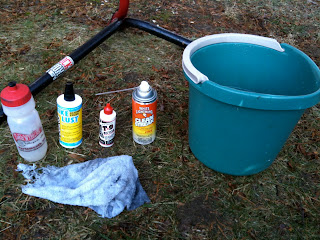A funny thing is happening in the
29er world lately. The 29-inch wheel grew out of a desire to roll faster in the
woods, to maintain momentum, and to smooth out bumpy terrain. For close to a
decade 29ers were a completely hardtail phenomenon, their inherently-longer
wheelbase and heavier wheels limiting their application.
 Full suspension 29ers were decidedly
tank-like, plowing over rough terrain, but sluggish in tight terrain and
anything headed uphill. In our corner of the world the 2010 Specialized Epic FSR29er changed all that. Suddenly, there was a 100mm travel full suspension 29er
that did everything the best lightweight 26ers did, but with the added benefit
of rolling over the rocky, rooty trails of the Granite State on bigger wheels. On
a medium frame the wheelbase was only 13mm longer than the 26” wheel version.
Stronger, lighter 29er wheel options like Stans, Industry 9, Roval and ENVE
took away the weight penalty on extended climbs or in tight, technical terrain
where constant acceleration is the name of the game.
Full suspension 29ers were decidedly
tank-like, plowing over rough terrain, but sluggish in tight terrain and
anything headed uphill. In our corner of the world the 2010 Specialized Epic FSR29er changed all that. Suddenly, there was a 100mm travel full suspension 29er
that did everything the best lightweight 26ers did, but with the added benefit
of rolling over the rocky, rooty trails of the Granite State on bigger wheels. On
a medium frame the wheelbase was only 13mm longer than the 26” wheel version.
Stronger, lighter 29er wheel options like Stans, Industry 9, Roval and ENVE
took away the weight penalty on extended climbs or in tight, technical terrain
where constant acceleration is the name of the game.
We sold dozens of these bikes each
year since Specialized made them readily available in 2011. It became our
number one selling full suspension bike and revitalized our local mountain bike
scene (once one rider got on one everyone else they rode with started thinking seriously
about 29ers).
But this is a review of the 2013Stumpjumper FSR Elite 29er, not an Epic. The Stumpjumper, with an additional
inch of travel and more relaxed geometry, had been our best-selling full
suspension bike for close to a decade in its 26” version until the Epic 29 came along. Now, over 90% of
the full suspension bikes we sell are 29ers. Some of that is most likely because they just ride faster in the rough, rooty, rocky terrain with very few extended (1000 vertical-feet-plus climbs) we have here, but I think most of it is that full suspension 29ers have just evolved and improved.
Last year Specialized tweaked the
Stumpjumper FSR 29er geometry, and after sending people out on both our Epic and Stumpy Test Bikes
we ended up selling more Stumpy 29ers than Epic 29ers!
The 2013 Stumpy FSR Elite 29 is a
fantastic bike! It’s got 140mm of travel front and rear with a Fox Talas CTD
fork and a Fox/Specialized Brain rear shock. It's M5 aluminum frame with 142mm dropouts is light, stiff, and doesn't cost a fortune when you wrap it around a tree at 20 mph! It’s got a carbon SRAM S2200
crankset, SLX/XTR drivetrain, Avid Elixir 5 SL brakes and a 3-position Command
Post with internal frame routing and handlebar remote.
THE RIDE
On the trail the Stumpy is
well-balanced: it is a jack-of-all-trades It climbs the steep, technical power
climbs around these parts as the equal of any cross country bike, yet delivers
on the downhills like a completely different species. The brain on the rear
shock can be set up in a range of ways to accommodate a fast, smooth rolling
ride, a nasty, technical, rocky ride, or anything in between. The CTD feature
on the Fox Talas fork does likewise on the front end: it’s like having 2 or 3
bikes in one.
We have 2013 Stumpjumper FSR 29 test bikes in multiple sizes at the shop. $75/day gets you out riding one on your local trail, and if that's the spark that makes you decide you want one for yourself the $75 will go towards whichever one you want to buy!
As bike companies put more resources into 29 inch bike platforms they are finding ways to accentuate the benefits of bigger wheels over a wider variety of terrain and are minimizing any of the big wheel's traditional shortcomings. Longer travel models are incorporating the bigger wheels, and rumors are flying of 29" Specialized Enduros being seen at gravity events. 29ers have come a long way, and their future is decidedly bright!
You won't know until you ride one...
You won't know until you ride one...






